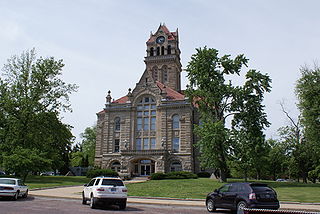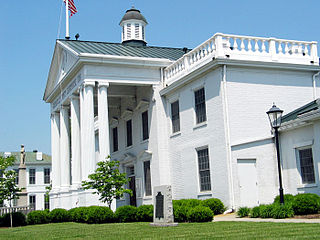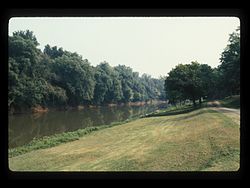
Burning Springs is an unincorporated community in Wirt County, West Virginia, United States. It takes its name from the natural gas which bubbled up through the spring and would burn when lit.

The Shepherdstown Historic District comprises the historic core of Shepherdstown, West Virginia. The town is the oldest in West Virginia, founded in 1762 as Mecklenburg. No structures are known to exist from the time before the town became known as Shepherdstown. The historic district is concentrated along German Street, the main street, with 386 contributing resources and 69 non-contributing elements. The chief representative period is the late 18th century, with many Federal style brick houses. German Street is also furnished with 19th-century "street furniture" such as metal fences, mounting blocks, wooden pumps and mature trees.
Spring Hill Cemetery Historic District is a national historic district located at Charleston, West Virginia. The district is a 172-acre (70 ha) site located on a series of tree shaded and landscaped hills overlooking central Charleston and includes the following cemeteries: Spring Hill Cemetery, Mountain View Cemetery, B'nai Israel Cemetery, Lowenstein Cemetery, and Mount Olivet Cemetery. It is West Virginia's largest cemetery complex. The district features Spring Hill Mausoleum, a stone faced reinforced concrete structure constructed in 1910. It includes the graves of West Virginia Governors William A. MacCorkle (1857–1930) and George W. Atkinson (1845–1925).

Salt Sulphur Springs is an unincorporated community in Monroe County, West Virginia, United States. Salt Sulphur Springs is located on U.S. Route 219, southwest of Union.
The Pence Springs Hotel Historic District is a national historic district located at Pence Springs, Summers County, West Virginia. It encompasses seven contributing buildings and two contributing structures. They are the Pence Springs Hotel Building (1916-1918), Pavilion / Casino (1919), Hotel Manager's Residence / Warden's Residence, Hotel Garage (1925), Golf Caddy House (1919), Pence Springs Bottling Works, and Pence Springhouse.

The West Virginia Capitol Complex is a 18-acre (7.3 ha) historic district located along Kanawha Blvd., E., in Charleston, West Virginia. It dates from 1925 and was listed on the National Register of Historic Places in 1974.

Town of Bath Historic District is a national historic district located at Berkeley Springs, Morgan County, West Virginia. The district encompasses 218 contributing buildings, 3 contributing sites, 6 contributing structures, and 1 contributing object. It consists of the community's central business district, along with the previously-listed Berkeley Springs State Park, a small industrial area east of the downtown, and residential areas surrounding the downtown which also contain several churches and two cemeteries. The buildings are generally two stories in height and are primarily built of brick, wood, and concrete block, and set on foundations of native limestone and brick. Located within the district boundaries are the previously listed Berkeley Springs Train Depot, T. H. B. Dawson House, the Clarence Hovermale House also known as the Mendenhall 1884 Inn, the Sloat-Horn-Rossell House, and the Judge John W. Wright Cottage.

Spring Mills Historic District is a national historic district located near Martinsburg, Berkeley County, West Virginia. It encompasses five contributing buildings, constructed between about 1790 and 1922, and two contributing sites. They include the Falling Waters Presbyterian Church (1834) and Manse (1922) and Stephen Hammond Mill, Miller's House, and Spring House. The buildings are of masonry construction. The sites are the Falling Waters Presbyterian Church Cemetery and the site of Dr. Allen Hammonds House.

Camp Washington-Carver Complex, also known as West Virginia 4-H Camp for Negroes, is a historic camp and national historic district located near Clifftop, Fayette County, West Virginia. The district encompasses four contributing buildings and two contributing structures, the most notable being the Great Chestnut Lodge, a log building of unusual size and structural character. It is the largest log structure built entirely of chestnut in West Virginia. It was built in 1941–1942, and is a 1 1/2 story building in the form of a modified Latin cross with a gabled block and a gabled wing or ell. Also on the property are a log cottage (1940), two frame dormitories (1942), a water tower (1940), and a small pond (1940). The camp was established by an act of the West Virginia legislature in 1937, and developed as a project of the Works Progress Administration starting in 1939.

Jackson's Mill State 4-H Camp Historic District, also known as West Virginia University Jackson's Mill, is a historic 4-H camp and national historic district near Weston, Lewis County, West Virginia. The district includes 23 contributing buildings, 4 contributing sites, 4 contributing structures, and 2 contributing objects. The camp was established in 1921 as the first statewide 4-H camp in the United States. The district includes buildings related to the site's inception as a homestead and agricultural area as well as its current manifestation as a youth camp facility and conference center.

Elm Hill, also known as the Campbell-Bloch House, is a historic house and national historic district located near Wheeling, Ohio County, West Virginia. The district includes two contributing buildings and one contributing site. The main house was built about 1850, and is a 2+1⁄2-story, brick house with a low 2-story wing in the Greek Revival style. It has an L-shaped plan, a 3-bay entrance portico, and hipped roof with an octagonal bell-cast central cupola. The interior has a central formal hall plan. Also on the property are a contributing brick, spring house / smoke house and a small cemetery dating to about 1835.

Caldwell & Drake was a construction firm based in Indiana. It included George W. Caldwell and Lester Drake.

Colonial Village is a historic garden apartment complex located at Arlington County, Virginia, United States. It contains 226 contributing buildings built in four stages between 1935 and 1940. The buildings hold approximately 1,055 apartments. The brick Colonial Revival-style buildings are situated around courtyards with clusters of five and seven buildings to larger groupings of up to thirteen. Colonial Village was the first Federal Housing Administration-insured, large-scale, rental housing project erected in the United States. The complex has been converted to condominiums split into three phases and two apartment complexes: Colonial Village Apartments and Colonial Village West.

Homestead Dairy Barns, also known as Miller Mill and Inn at Gristmill Square, is a historic dairy barn complex and national historic district located at Warm Springs, Bath County, Virginia, USA. The district encompasses seven contributing buildings. The complex consists of the Main Barn with its attached tile double silos, a Bottling Building, Milking Barn, Calving Barn, Ham House, Herdsman's Cottage, and Bull Barn. The complex was built by the Virginia Hot Springs Company in 1928 to support the operations of the nearby Homestead resort. They are frame buildings, many of which are clad in stucco and painted white with unifying green trim. They include repetition of Colonial Revival and Craftsman details throughout.

Craig Healing Springs, also known as the Craig Springs Conference Grounds, is a historic resort property located at Craig Springs, Craig County, west of New Castle, Virginia. It encompasses 23 contributing buildings and 1 contributing structure associated with the Craig Healing Springs resort. They include mostly frame resort cottages in addition to the two-story, brick Oak Lodge. It contains guest rooms and the facilities for the healing baths. The core of the complex is the building known as "Central," which.contained guest registration, rooms, and the kitchen and dining facilities. The property also includes a former dance pavilion, used as an assembly hall. A gazebo marks the location of the springs and stands northwest of the dance pavilion. The resort was incorporated in 1909, and the health spa-resort complex flourished with the advent of automobile travel in the years between the two world wars. It declined in popularity in the 1950s, and was purchased in 1960, as a retreat and conference center for the Christian Church in Virginia.

Mountain View Farm, also known as Pioneer Farms, is a historic home and farm complex located near Lexington, Rockbridge County, Virginia. The main house was built in 1854, and is a two-story, three-bay, brick dwelling, with a 1 1/2-story gabled kitchen and servant's wing, and one-story front and back porches. It features a Greek Revival style interior and has a standing seam metal hipped roof. The property includes an additional 13 contributing buildings and 3 contributing structures loosely grouped into a domestic complex and two agricultural complexes. They include a two-story, frame spring house / wash house, a frame meathouse, a one-room brick building that probably served as a secondary dwelling, a double-crib log barn, a large multi-use frame barn, a slatted corn crib with side and central wagon bays and a large granary.

Rockbridge Alum Springs Historic District, also known as Jordan Alum Springs, and now known as Rockbridge Alum Springs - A Young Life Camp, is a historic 19th-century resort complex and national historic district near California, Rockbridge County, Virginia, United States. The district encompasses 16 contributing buildings, 10 contributing sites, and 4 contributing structures dating primarily to the 1850s, and associated with the operations of the Rockbridge Alum Springs, a popular 19th- and early-20th century mountain resort. The buildings are the barroom, store/post office, Montgomery Hall, the Gothic Building, the Alum Springs Pavilion, two cottages of Baltimore Row, the Ladies Hotel, four cottages of Kentucky Row, Jordan's House, a servant's quarters, a slave quarters, and a storehouse. The remaining structures are a well and the stone spring chambers and gazebo and bandstand of the Jordan Alum Springs. The sites are primarily those of demolished cottages. It is one of the best-preserved antebellum springs resort complexes in Virginia. The resort remained in operation until 1941. It is currently owned and operated by Young Life, a non-denominational Christian youth organization, and has been operated as a year-round campground since 1992.

Maiden Spring is a historic home and farm complex and national historic district located at Pounding Mill, Tazewell County, Virginia. The district encompasses eight contributing buildings, two contributing sites, and one contributing structure. The main house consists of a large two-story, five-bay, frame, central-passage-plan dwelling with an earlier frame dwelling, incorporated as an ell. Also on the property are the contributing meat house, slave house, summer kitchen, horse barn, the stock barn, the hen house, the granary / corn crib, the source of Maiden Spring, the cemetery, and the schoolhouse. It was the home of 19th-century congressman, magistrate and judge Rees Bowen (1809–1879) and his son, Henry (1841-1915), also a congressman. During the American Civil War, Confederate Army troops camped on the Maiden Spring Farm.

Greensville County Courthouse Complex is a historic courthouse complex located at South Main Street between Hicksford Avenue and Spring Street in Emporia, Virginia. The three contributing buildings are the two-story, porticoed courthouse built in 1834, the clerk's office built in 1894, and the former Greensville Bank Building, now the county administrator's office, in 1900 and 1907. The courthouse originally took a Palladian form, but was remodeled between 1907 and 1910 to take a Beaux-Arts appearance. The clerk's office was considerably enlarged in 1916 and the Georgian-style facade added in 1961. The interior of the county administrator's office features elaborate pressed-tin walls and ceilings manufactured by the local concern, H.J. Klugel. The buildings are set upon the courthouse square, which includes a cannon honoring residents who participated in World War I, and a Confederate monument.

California is a ghost town in northern Wirt County, West Virginia. It lies along the Hughes River, between the river and West Virginia Route 47, about half a mile below the Ritchie County line, and just above the intersection of Route 47 with California House Road, or County Route 47–1.




















